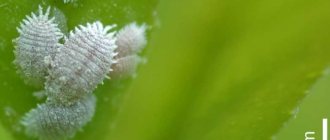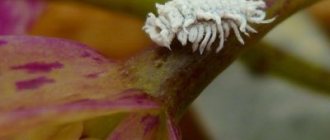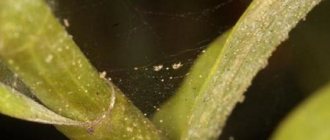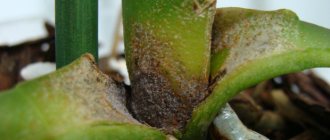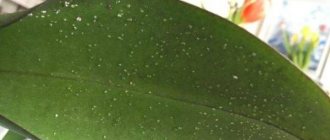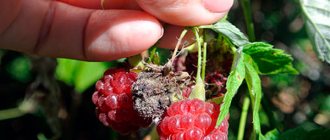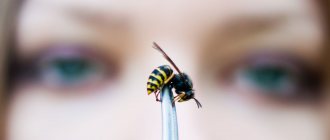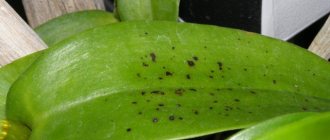With improperly organized care, the orchid is completely a harmful insect may appear mealybug.
It, feeding on the sap of the plant, methodically destroys the foliage and roots of the plant. If urgent measures are not taken, the flower may die.
Below we will tell you in detail how to get rid of mealybugs on an orchid. But first, let’s find out what kind of pest this is.
Description of the pest
The pest belongs to the hemiptera family and is a close relative of the scale insect. Both species are sap-sucking pests.
Types and popular name
This representative of the pest is popularly called white lice. And now science knows more than 1,600 species of these insects that live on various plants. In the photo you can see one of the common types of mealybug.
There are many types of mealybug.
Here are the few species that can be found on an orchid:
- Bristly - has a dense coat and longer hind legs;
- Primorsky - this species is the most prolific, as females lay 400 eggs in one clutch;
- Grape - lives in the southern regions of Russia, and females are colored brown.
IMPORTANT! Whatever mealybug appears on the orchid, it must be eliminated as quickly as possible, otherwise the plant will die.
Description of the adult and larva
In appearance, the insect is similar to the scale insect, but, unlike it, is not covered with a shell and has a white body color. The insect is very mobile and therefore, if it is noticed on one orchid, the plant should be immediately isolated in a quarantine zone, and the remaining orchids should be carefully examined for the presence of the pest.
The mobility of an insect does not depend on its age . Depending on the species, the size of the mealybug can be from 3 to 12 mm.
Male:
- Has wings;
- Well developed limbs;
- It has 2 tail filaments on the abdomen;
- Does not have an oral cavity (do not eat during their life).
Female:
- Has an oral cavity;
- Some species do not have legs;
- They have a cotton-like sac from which live larvae emerge, which are very mobile immediately after birth.
Larva:
- Mobile for some time before molting;
- Then it sticks to the leaf and will remain motionless until molting occurs;
- It has a white body color and looks like a small worm.
IMPORTANT! The female begins her reproduction only in secluded places of the plant, for example in the leaf axils.
Types of scale insects
Among the many representatives of the scale insect family, there are several species that cause concern to lovers of indoor flowers.
- Bristle mealybug (Pseudococcus adonidum) - damage to the plant is caused by females and larvae of the insect. The body of adults is orange or pink. It is covered with a powdery coating. Females reach a length of 5 mm, males are smaller. The pest produces a large amount of honeydew (sweet secretion), which causes the appearance of fungus. This species is viviparous; its representatives actively spread throughout the orchid.
- Seaside mealybug (Pseudococcus affinis) – this species is most widespread. The body of the female is elongated, the color is pinkish-gray. A powdery coating is clearly visible on its surface. Males grow up to 2 mm and use wings to move. Females do not fly, their length is 3-4 mm. Well-developed legs allow them to seek out the best places to feed and lay eggs.
- Citrus mealybug (Planococcus cirti) – The color of the pest ranges from yellow to brown. The body is covered with a waxy coating, with thick bristles visible on the sides. Females leave behind a sticky, sweet honeydew.
Information. More than 2,000 species of mealybugs have been found in the world. Most prefer tropical latitudes; 300 species are found in Europe.
Damage to the plant
Under the conditions necessary for it, the mealybug quickly spreads throughout the orchid. If the disease is detected in the initial stage, treatment will be faster and more effective. By feeding, the harmful insect harms the plant :
- Deprives the nutritional juice necessary for uniform development;
- The plant is stunted;
Mealybugs cause the orchid leaves to turn yellow. - Foliage damaged by bites takes on a yellow tint;
- The plaque left by the scale insect attracts fungal and bacterial diseases.
It is necessary to take treatment measures in a timely manner so as not to lose the plant.
Chemical and biological agents
You can rid your orchid of pests using the following medications:
- Aktara.
- Actellik.
- Fitoverm.
- Agravertine.
- BI-58.
Aktara: use and dosage in ampoules
It has an extensive intestinal-contact effect and helps well in the fight against various types of insects from scale insects to thrips and aphids. This is a safe product that provides the orchid with protection from pests for 2 weeks. Available in ampoules and powder. Ampoules are often used to treat indoor plants.
Dosage of dilution of the drug: a 1.2 gram ampoule is diluted in 6 liters of water and the plant is sprayed.
There should be weekly intervals between treatments. Aktar can be used in combination with Epin and Zircon.
Actellik: how to dilute?
A systemic insectoacaricidal agent that has proven itself in the fight against harmful insects that attack orchids. For long-term protection, a single treatment is usually sufficient. Actellik serves as a working solution. 1 ml of product is diluted in one liter of liquid.
The roots and stems, as well as foliage, are treated with the drug. If necessary, the procedure is repeated after 7 days. For maximum effectiveness, the treated plant is placed in polyethylene and kept for several days in a ventilated room.
Actellik is a drug of the second class of toxicity. When using it, it is important to follow safety precautions, use gloves, goggles, a respirator, and carry out processing outdoors.
Spray Bona forte
Suitable for getting rid of many crawling and flying insects.
It is best to carry out the treatment in the morning or evening in diffused light. Before use, it is better to test the spray on several leaves. If after 1-2 days everything is in order, then you can completely irrigate the flower. If necessary, the soil can also be treated with a spray.
Fitoverm
Biological insectoacaricidal drug that helps in the fight against mealybugs, aphids, mites, thrips. The remedy is used based on the type of parasite. To destroy spider mites, 1 ml of concentrate is diluted in 1 liter of liquid. For aphids – 1 ampoule in 600 ml of water. For thrips – 1 ampoule in 0.5 liters of water. In other cases, the dosage is 1 ml of product per 1 liter of liquid.
To destroy parasites, spraying with Fitoverm must be performed 4 times with an interval of 10 days.
Infection
Symptoms
To determine what kind of pest an orchid is affected by, it is necessary to diagnose it correctly , and for this you need to know the signs of damage to the plant.
The scale insects gather in groups in the axils of leaf blades and their undersides.
The scale insect can be seen with the naked eye, as the length of its body is quite noticeable. First of all, these are cotton bags where the female parasites lay their clutches. The plant seems to be covered with cotton balls.
How does infection occur?
You can introduce a pest:
- By purchasing an already infected plant specimen in a store;
- Or bring larvae from contact with infected flowers.
Therefore, newly purchased flowers are always placed in a quarantine zone to be sure that they are free of pests.
Causes
Possible reasons why an orchid may become infected:
- Constant bays of plants;
Mealybugs often appear due to overwatering or low temperatures. - Low temperatures;
- When dead parts of a plant are removed at the wrong time.
IMPORTANT! To prevent the plant from being attacked by a pest, it must be properly cared for.
External signs
Initially, the insect is located only in the axils of the leaves. But in the process of its reproduction it spreads very quickly throughout the entire plant, covering it with a cottony coating :
- Flowers;
- Peduncles;
- Leaves;
- Then its larvae fall into the ground and begin to destroy the root mass.
The infected flower is evenly covered with cotton balls in which pests grow.
How to get rid of it: pest control measures
If a mealybug is detected on an orchid, several actions must be taken immediately:
- Cut off and destroy flower stalks with buds.
- Remove pests from the affected parts of the plant using a toothpick or tweezers.
- Treat the leaf blades with a cotton pad soaked in alcohol or calendula tincture.
In some varieties, young scale insects prefer to settle under the young scales covering the pseudobulbs. In this case, the scales must be removed, and the pseudobulb must be treated with a sponge, which allows you to eliminate individuals that are not yet visible to the eye. If the leaves of the plant are affected, they are also removed.
Next, you need to process the flower.
Fighting methods
How to deal with mealybugs so as not to greatly harm the orchid?
Physical methods
Physical pest control measures can be used. If the infection is in the initial stage, then the harmful insect can be gotten rid of mechanically without using chemicals.
Methodology
How to cure an orchid physically? To remove the parasite from the leaf mass, you will need :
- Cotton pad;
- Or a soft toothbrush.
They are moistened in soapy water and the orchid is carefully washed from the cotton balls. In hard-to-reach places, you can use cotton swabs, since before treatment you need to carefully get rid of all insects.
Hot shower
There are different ways to remove mealybugs on flower buds. One of them is watering the orchid with a hot shower.
The water temperature, comfortable for orchids, should not exceed 30 degrees . This can be easily determined by placing your hand under running water. If water is pleasant for a person in terms of warmth, then the orchid will like it. But the thermometer is still more accurate
